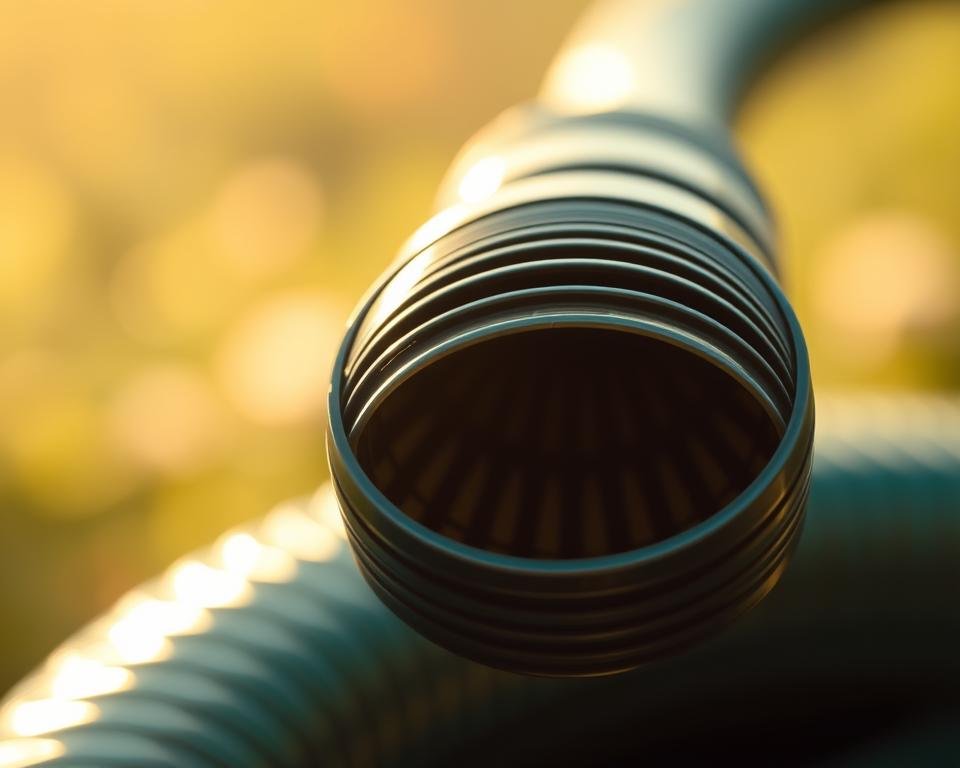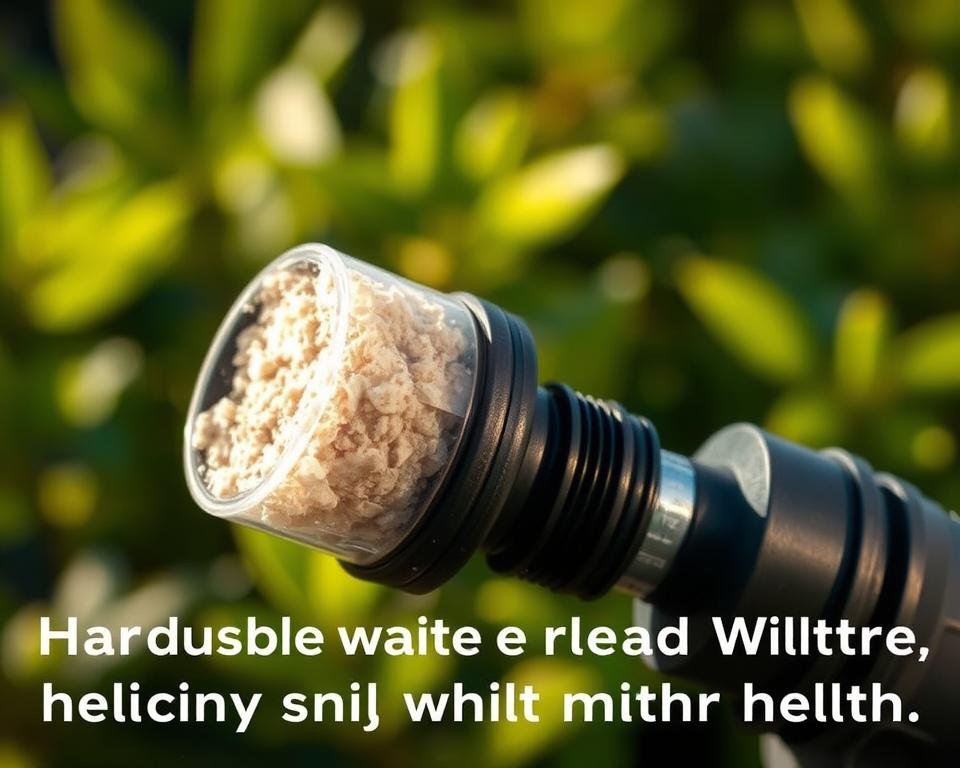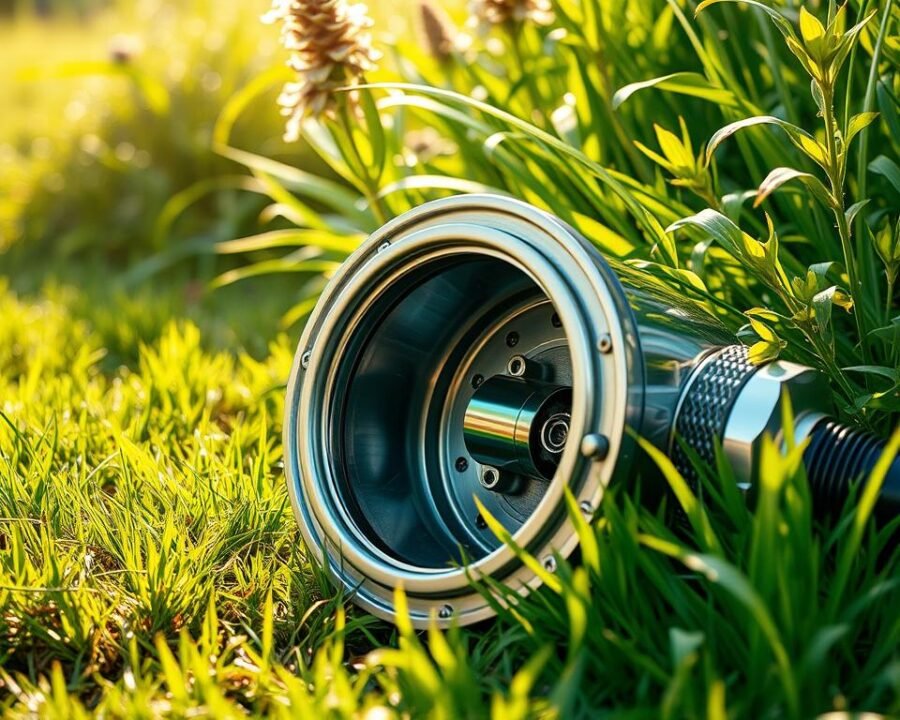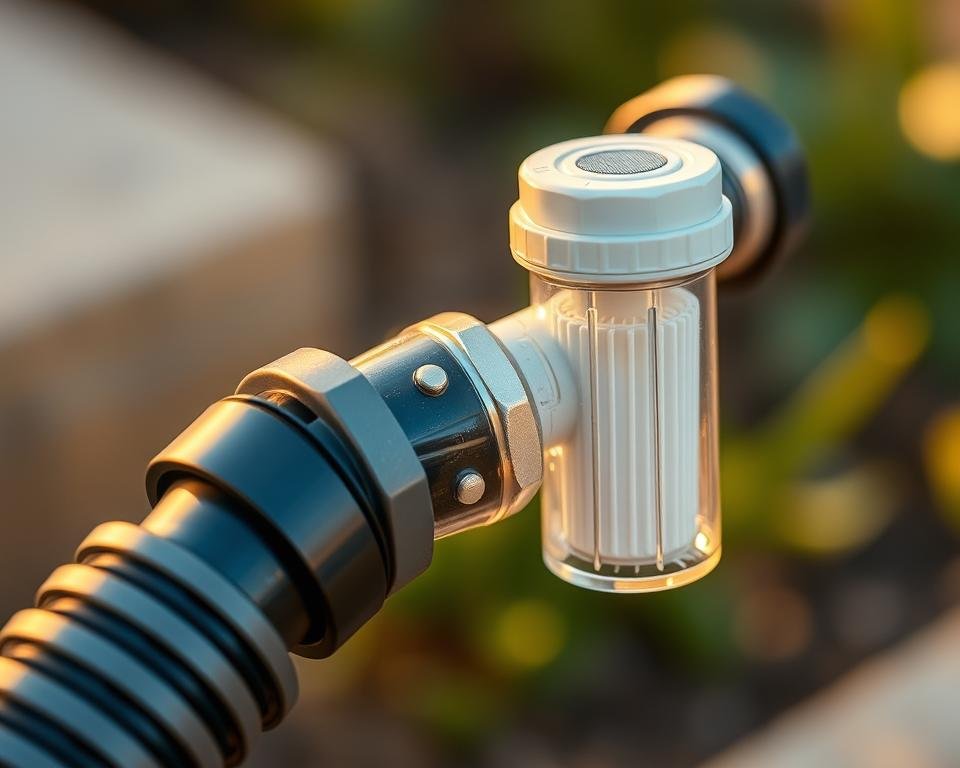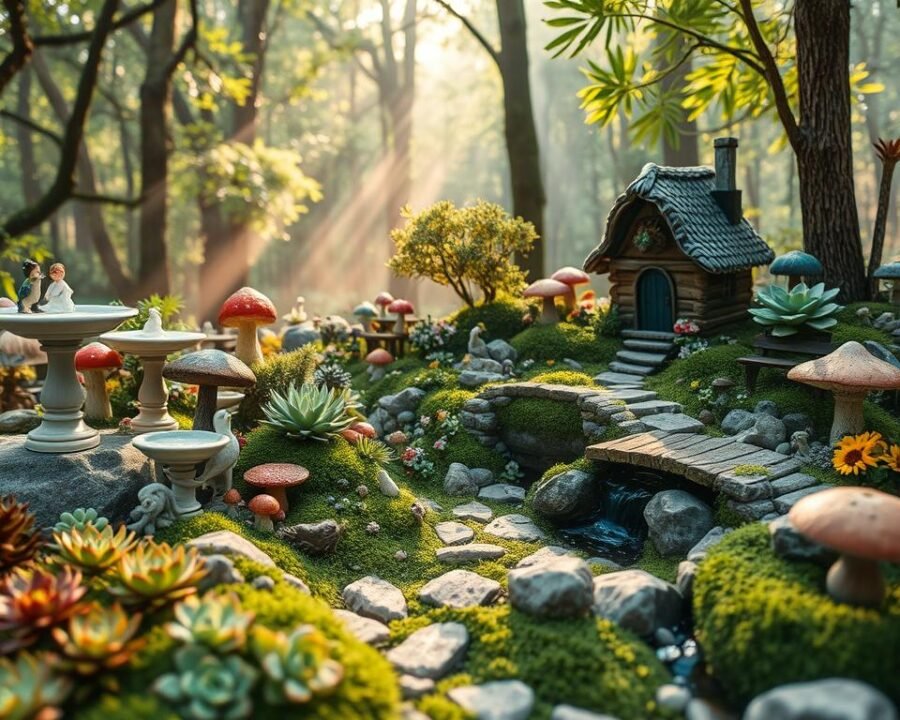Enhance Your Garden Hose with a Calcium Filter

Ever had your water flow slow down or stop while watering plants, washing cars, or filling pools? This usually happens because of mineral buildup and sediment in your hose.
Using a calcium filter for garden hose can make watering much better. It cuts down on mineral buildup and sediment, giving you a smoother water flow.
Imagine watering plants, washing cars, or filling pools without worrying about clogs or mineral buildup. With a calcium filter, you can say goodbye to these frustrations and enjoy a more efficient watering experience.
Key Takeaways
- Reduces mineral buildup and sediment in your garden hose
- Improves water flow and reduces clogs
- Easy to install and use with standard garden hoses
- Suitable for various applications, including watering plants, washing cars, and filling pools
- Can be used with soft or hard water and city or well water
What is a Calcium Filter for Garden Hoses?
Using a calcium filter with your garden hose can make your plants healthier. It removes minerals like calcium that can clog your hose’s nozzle. This helps keep your hose working well.
Calcium buildup happens when water with lots of minerals flows through your hose. These minerals can stick to the hose and nozzle. This can make your water flow less and might damage your gardening tools.
Understanding Calcium Buildup
Calcium buildup is a big problem for gardeners who use hard water. Hard water has lots of minerals like calcium and magnesium. These can cause scaling and clogging in hoses and nozzles. The universal calcium inhibitor filter helps by trapping sediment and reducing mineral buildup. This makes your gardening tools last longer.
Key Benefits of Using a Calcium Filter
Using a calcium filter has many benefits. It reduces sediment and mineral buildup. It also makes water flow better and with more pressure. This means your plants will be healthier and you’ll water more efficiently.
| Benefit | Description |
|---|---|
| Reduced Sediment | Traps sediment, preventing clogs in the hose and nozzle. |
| Minimized Mineral Buildup | Reduces calcium and other mineral deposits, improving water flow. |
| Improved Water Pressure | Maintains optimal water pressure, ensuring efficient watering. |
By using a garden hose water filter, you can protect your plants from harmful minerals. This ensures a healthier garden for you.
How Calcium Affects Your Garden Plants
Hard water, full of calcium, can change how soil works and affect plant growth. Using calcium-rich water for plants can cause calcium to build up in the soil. This buildup can harm both soil health and plant growth.
Impact on Soil Health
Calcium buildup can change soil structure and make it less fertile. Soils with lots of calcium become more alkaline. This is bad for plants that like acidic conditions.
- Soil pH imbalance due to increased alkalinity
- Reduced availability of nutrients for plants
- Potential for increased soil compaction
Using a garden hose hard water filter can help. It reduces the calcium in the water.
Effects on Plant Growth
Calcium-rich water can affect plants in many ways. While calcium is good for plants, too much is bad.
- Stunted growth due to nutrient imbalances
- Leaf chlorosis or yellowing
- Reduced root development
In summary, calcium buildup from hard water can harm soil and plant growth. Gardeners can use a garden hose hard water filter to help.
Features to Look for in a Calcium Filter
To get the most out of your calcium filter, it’s key to know its main features. When picking the right calcium filter for your garden hose, several things matter. A good filter can greatly help your plants by lessening hard water’s bad effects.
Filter Type and Efficiency
The filter’s type and how well it works are very important. There are many types of filters, including chemical-free ones. For example, a garden hose water softener is great for those who don’t want to use chemicals. A filter’s efficiency is how well it removes calcium and other minerals that make water hard.
When looking at filter efficiency, think about these:
- Flow rate: Make sure the filter can handle your garden hose’s water flow.
- Calcium removal percentage: Choose filters that remove a lot of calcium.
- Maintenance requirements: Some filters need more upkeep than others.
Ease of Installation
How easy it is to install the filter is also very important. A filter that’s easy to install saves you time and effort. Many calcium filters today are made to be simple to set up. For example, some have female and male pipe threads that fit garden hose adapters, making them easy to connect.
Here’s a look at different installation features:
| Filter Model | Installation Type | Ease of Use |
|---|---|---|
| Model A | Screw-on | Easy |
| Model B | Clip-on | Very Easy |
| Model C | Inline | Moderate |
By looking at these factors, you can pick a calcium filter that fits your needs and helps your garden. Remember, the right filter can really help your plants’ health.
Top Brands Offering Calcium Filters
Aquascape, Camco, and Simple Solution are leaders in calcium filters for garden hoses. They offer effective solutions to prevent calcium buildup. This helps keep plants healthy and extends the life of your hose.
Aquascape
Aquascape is a well-known name in gardening and landscaping. They make high-quality calcium filters to remove minerals from water. Their filters are engineered to provide clean water for plants, boosting their growth and health.
Camco
Camco is a trusted brand with a variety of calcium filters for garden hoses. Their products are easy to use and effective. This makes them a favorite among gardeners.
Simple Solution
Simple Solution offers easy-to-use calcium filter systems. Their products are designed to reduce calcium buildup in hoses. This ensures plants get a steady water supply.
| Brand | Filter Type | Ease of Installation | Effectiveness |
|---|---|---|---|
| Aquascape | High-capacity filter | Easy | High |
| Camco | Multi-stage filter | Moderate | Very High |
| Simple Solution | Inline filter | Very Easy | High |
By looking at these top brands, you can choose the best calcium filter for your garden hose. This ensures your plants get the best care.
How to Install a Calcium Filter
Installing a calcium filter for your garden hose is easy and can greatly help your plants. It stops calcium buildup, which can clog hoses and harm plants. We’ll show you how to install it, so you can see the benefits.
Step-by-Step Installation Guide
To install a calcium filter, just follow these steps:
- First, attach the filter directly to your water spigot.
- Next, connect your garden hose to the filter.
- Make sure all connections are tight to avoid leaks.
Key Connection Points:
| Connection Point | Description |
|---|---|
| Water Spigot to Filter | Attach the calcium filter to the water spigot to start filtering your water. |
| Filter to Garden Hose | Connect your garden hose to the calcium filter to get filtered water to your plants. |
Common Installation Mistakes to Avoid
When installing a calcium filter, avoid these common mistakes:
- Not securing the filter properly, leading to leaks or detachment.
- Failing to check if the filter fits your garden hose or spigot.
By following these steps and avoiding common mistakes, you can install a calcium filter on your garden hose. This simple step can greatly improve your garden’s health and look.
Maintaining Your Calcium Filter
Keeping your calcium filter in good shape is key for your garden hose system’s life. A working filter means your plants get the best care. It also makes your garden hose last longer. We’ll talk about why regular upkeep is important and how to know when to replace your filter.
Regular Maintenance Tips
To keep your calcium filter in top shape, regular care is essential. Here are some tips:
- Check your filter often for wear and tear signs.
- Follow the maker’s guide to clean the filter and avoid clogs.
- Swap out the filter media as the maker suggests for best results.
For a garden hose purification system like the one at Dead Fly Zone, these steps boost its performance.
Signs Your Filter Needs Replacement
Even with regular care, filters have a shelf life. Here are signs it’s time for a new one:
- A drop in water pressure is noticeable.
- Calcium buildup or scaling is seen on your hose or plants.
- The filter is beyond its replacement date.
Replacing your filter when needed keeps your garden hose working well. It also keeps your plants healthy. Regular maintenance and timely replacements are simple steps to protect your garden hose system.
How Calcium Filters Improve Water Quality
Calcium filters are key in making water better for garden plants. They reduce the harm of hard water. Hard water has too much calcium and magnesium, which can hurt plant health.
Using a calcium filter for garden hose lowers the mineral levels in water. This makes a better place for plants to grow.
Reduction of Hard Water Effects
Hard water can make soil hard, stopping roots from growing and water from getting in. A calcium filter cuts down on these problems by removing extra minerals.
This makes the soil healthier and helps water work better in the garden. Plants can then drink more water, growing stronger and healthier.
Enhancing Nutrient Absorption
Using a calcium filter improves water quality, helping plants take in nutrients better. Hard water can block nutrient uptake, but a calcium filter balances this out.
This leads to plants that grow strong and healthy. They also fight off diseases and pests better. Calcium filters make gardening more sustainable and productive.
DIY Calcium Filter Options
Building a calcium filter for your garden hose is easy and fun. You just need a few simple materials and some basic steps. This way, you can cut down on calcium buildup and make your garden healthier.
Materials You’ll Need
To start your DIY calcium filter, gather these items:
- A filter housing or container
- Calcium-removing media (like resin or activated carbon)
- Tubing and connectors for your garden hose
- Teflon tape or pipe dope for tight connections
You can find these materials at most hardware stores or online. Pick the right calcium-removing media. Look at its type, quality, and if it meets local rules.
Step-by-Step Instructions
Here’s how to make your DIY calcium filter:
- Clean and dry your filter housing well.
- Put the calcium-removing media in the housing, as the maker says.
- Attach the tubing to the housing and hose. Use Teflon tape or pipe dope for a tight fit.
- Test the filter by running water through it. Check for leaks or problems.
By following these steps, you can make a working calcium filter. It will help reduce calcium buildup and make your garden healthier.
DIY calcium filters save money, let you customize, and feel good about making something yourself. But, remember the downsides. You’ll need to keep it up and it might not work as well as others.
Frequently Asked Questions About Calcium Filters
Exploring calcium filters is key for gardeners. They help keep plants healthy and strong. Knowing the basics can make a big difference.
How Often Should a Filter Be Replaced?
How often to replace a calcium filter varies. It depends on the filter type, how much you use it, and your water’s calcium level. Usually, you’ll need to replace it every 3 to 6 months. But, some filters can last up to a year or more with good care.
Here are things to think about for your filter’s replacement:
- Water usage: If you use your hose a lot, you might need to change the filter more often.
- Filter type: Each filter has its own lifespan. Check what the maker says.
- Calcium levels: If your water is very hard, you might need to change the filter more often.
Can Calcium Filters Be Used with Other Hoses?
Yes, calcium filters work with most garden hoses. But, make sure your hose and filter are compatible. This avoids any problems.
When picking a calcium filter, keep these in mind:
| Hose Type | Filter Compatibility |
|---|---|
| Standard Garden Hose | Most calcium filters are compatible |
| Soaker Hose | Check manufacturer’s specifications |
| Spray Nozzle Hose | Some filters may not be compatible |
Always check the manufacturer’s advice before buying. This ensures your filter fits your hose.
Conclusion: The Value of a Calcium Filter
Using a calcium filter for your garden hose can greatly improve your plants’ health. These filters lower the calcium in water. This helps prevent hard water’s negative effects on soil and plant growth.
Impact on Plant Health
A calcium filter for garden hoses is key for plant health. It reduces calcium in the soil. This helps plants grow stronger roots and absorb nutrients better, making them more vibrant and healthy.
Investing in a Calcium Filter
We suggest investing in a calcium filter for your garden hose. It offers many benefits like better plant health, less soil damage, and cleaner water. This investment helps create a sustainable and thriving garden.
FAQ
What is a calcium filter for a garden hose?
A calcium filter for a garden hose removes calcium and minerals from water. This reduces buildup and sediment that can clog nozzles and harm plant growth.
How often should I replace my calcium filter?
The frequency of replacing a calcium filter depends on the manufacturer’s advice and how often you use it. Usually, you should replace it every 3-6 months. But this can change based on the product and your water’s condition.
Can I use a calcium filter with other hoses?
Yes, you can use a calcium filter with other hoses. But make sure to check if it’s compatible first. Some filters are made for specific hose sizes or types, so pick one that fits your hose.
Will a calcium filter improve the health of my plants?
Yes, a calcium filter can make your plants healthier. It reduces the impact of hard water and helps plants absorb nutrients better. By removing minerals and sediment, it supports healthy plant growth.
Are DIY calcium filters effective?
DIY calcium filters can work well if you use the right materials and install them correctly. But, they might not be as good as commercial ones. They could also not last as long.
How do I maintain my calcium filter?
To keep your calcium filter in good shape, check it often for damage and clean it as the maker says. Replace it when needed. Keeping it up will help it work well.
Can a calcium filter be used with a garden hose that has a spray nozzle?
Yes, you can use a calcium filter with a garden hose that has a spray nozzle. It’s actually a great choice. It helps prevent mineral buildup and clogs in the nozzle, which is good for your garden.
